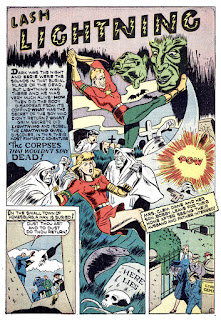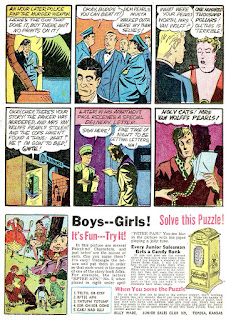This is an opportunity to update my old Frankenstein Friday feature, from the earliest days of this blog. So I am taking it with this oddball story from Prize Comics #24 (1942).
It is written and drawn by Frankenstein’s comic book creator, Dick Briefer, in the first of the three versions he published (monstrous, comedy, and Karloff-style) until 1954. His usual nemesis in these early tales, Bulldog Denny, has some other important government business to attend to, so he turns over tracking down and subduing the Frankenstein monster to other of Prize Comics’ featured players. Had I been Bulldog, I would have passed over the comedy duo of the General and the Corporal, but apparently he wanted to give equal time to all, even the buffoons among the group.
At the end it looks like Frankenstein is indeed done for. But, he is a monster, and you cannot keep a good monster down for long. So says everyone who ever made money by making a sequel of a famous (or infamous) monster movie.
Friday, March 30, 2018
Wednesday, March 28, 2018
Number 2160: The wrong kind of love
Note to younger readers of this blog: there was a time when people had to communicate by telephone (connected by landlines), radio, and by writing letters. Not e-mails, mind you...not tweets, not Facebook postings, but actual letters penned by hand, enclosed in an envelope with an address, and a postage stamp affixed. Can you imagine such a world? I lived through it and yet it seems harder to imagine every day.
Also, before all of those Internet matchmaking sites there were lonely hearts and penpal clubs (usually advertised in the back pages of magazines) for those looking for someone to share their life. I never participated in any of that, because as with modern digital versions, there are too many things than can go wrong. Like for Cindy, who rolls up calendars and puts them in mailing tubes, and decides to enclose a personal note with her address to maybe meet someone “wonderful in my life.” It’s a long shot, fraught with potential problems. And since this is a love comic, there are problems.
Before you launch into this short story from All True Romance #3 (1951), written and drawn by the Iger Studio, please notice the splash panel. That scene does not appear in the story. It looks as if Cindy is in imminent danger. Her sleeve is torn. Uh-oh. Luckily in the story the “danger” is more the rejection by the guy with whom she has had a correspondence. He is a cad, but thankfully no rapist.
Also, before all of those Internet matchmaking sites there were lonely hearts and penpal clubs (usually advertised in the back pages of magazines) for those looking for someone to share their life. I never participated in any of that, because as with modern digital versions, there are too many things than can go wrong. Like for Cindy, who rolls up calendars and puts them in mailing tubes, and decides to enclose a personal note with her address to maybe meet someone “wonderful in my life.” It’s a long shot, fraught with potential problems. And since this is a love comic, there are problems.
Before you launch into this short story from All True Romance #3 (1951), written and drawn by the Iger Studio, please notice the splash panel. That scene does not appear in the story. It looks as if Cindy is in imminent danger. Her sleeve is torn. Uh-oh. Luckily in the story the “danger” is more the rejection by the guy with whom she has had a correspondence. He is a cad, but thankfully no rapist.
Monday, March 26, 2018
Number 2159: Harvey K. lashes that lightning!
A couple of days ago I was comparing wannabe satirical comic books to Mad, and noted what the imitators lacked was Mad creator Harvey Kurtzman. Today I have a very early example of Kurtzman’s comic book work. I mean wayyyy early; Kurtzman was born in 1924, and this episode of “Lash Lightning” was published in 1942, which made Harvey about 18.
Kurtzman worked for Louis Ferstadt, a WPA artist* who took up drawing comic books in their early days. I have shown some early Kurtzman before, but when I checked it against the Grand Comics Database I saw they had “Harvey Kurtzman ?” for pencil and inking credits. They just aren’t sure. Can I be 100% sure? No, but I am leaning strongly toward Kurtzman being the artist. One, his initials are on the tombstone on the right hand side of the splash panel. It is hard to read, but it is an H.K. The other thing I noticed immediately is a youthful appropriation of Jack Kirby’s style for exaggerated action. Kirby was a master of action poses, and I visualize a young Harvey at a drawing board with copies of open Jack Kirby comic books.
This would have been a great school for Kurtzman, working against deadlines, drawing superheroes in action. He was drafted, served, came home, re-entered the comic book business, and by then had developed his own style.
*WPA — Works Progress Administration
Kurtzman worked for Louis Ferstadt, a WPA artist* who took up drawing comic books in their early days. I have shown some early Kurtzman before, but when I checked it against the Grand Comics Database I saw they had “Harvey Kurtzman ?” for pencil and inking credits. They just aren’t sure. Can I be 100% sure? No, but I am leaning strongly toward Kurtzman being the artist. One, his initials are on the tombstone on the right hand side of the splash panel. It is hard to read, but it is an H.K. The other thing I noticed immediately is a youthful appropriation of Jack Kirby’s style for exaggerated action. Kirby was a master of action poses, and I visualize a young Harvey at a drawing board with copies of open Jack Kirby comic books.
This would have been a great school for Kurtzman, working against deadlines, drawing superheroes in action. He was drafted, served, came home, re-entered the comic book business, and by then had developed his own style.
*WPA — Works Progress Administration
Friday, March 23, 2018
Number 2158: Wife of the werewolf
Mad was a successful comic and that brought out a bunch of imitators in the early fifties. No one had the touch of Mad creator, editor, writer and all around control freak Harvey Kurtzman. But there are some better than average stories in that pile of humor/satire comics that vied for some of the Mad money. John Benson thought enough of “Oh, for the Life — of a Wife — of a Werewolf” to include it in his superb 2012 collection of Mad imitations, The Sincerest Form of Parody.
It was produced by the Iger Studio, and appeared in Bughouse #2 (1954), an Ajax-Farrell comic. I laughed at the menu the werewolf is holding on page 3: “Roast artist....$2.75. Roast writer....30¢. Hashed politician....10¢." I am glad it has its values straight.
It was produced by the Iger Studio, and appeared in Bughouse #2 (1954), an Ajax-Farrell comic. I laughed at the menu the werewolf is holding on page 3: “Roast artist....$2.75. Roast writer....30¢. Hashed politician....10¢." I am glad it has its values straight.
Wednesday, March 21, 2018
Number 2157: The Fox goes to a nightclub
The Fox is another costumed hero who has no super powers. He is Paul Patton, a newspaper photographer with a hidden camera hidden in his chest emblem. The first body cam?
MLJ, who published Blue Ribbon Comics #8 (1940), where this story appeared, cut back its roster of costumed and super heroes over time, and became Archie Comics. While this episode of the Fox seems relatively tame, early MLJ had a reputation for rowdiness.
The Fox was gone after the last issue of Blue Ribbon (#22, 1942), not to be seen until the mid-sixties, when Archie Comics resurrected their MLJ heroes.
Artist Irwin Hasen, who went on to draw Green Lantern for DC and in the fifties drew “Dondi,” a popular newspaper strip, was another of those early comic book journeymen. He died in 2015 at age 96.
MLJ, who published Blue Ribbon Comics #8 (1940), where this story appeared, cut back its roster of costumed and super heroes over time, and became Archie Comics. While this episode of the Fox seems relatively tame, early MLJ had a reputation for rowdiness.
The Fox was gone after the last issue of Blue Ribbon (#22, 1942), not to be seen until the mid-sixties, when Archie Comics resurrected their MLJ heroes.
Artist Irwin Hasen, who went on to draw Green Lantern for DC and in the fifties drew “Dondi,” a popular newspaper strip, was another of those early comic book journeymen. He died in 2015 at age 96.
Monday, March 19, 2018
Number 2156: Congo Bill in the jungle of dinosaurs
Congo Bill was a longtime second banana character for DC. I remember him from the fifties when he palled around with Janu, the Jungle Boy. (Here we go again, with grown men and young boys going on adventures together.) Quoting Wikipedia: “Congo Bill was a long-running DC Comics adventure comic strip, running in various DC Comics titles from 1940 until Action Comics #248 (January 1959), when Congo Bill was transformed into Congorilla (the title of the strip was likewise changed). The Congo Bill strip was a standard adventure strip, often reminiscent of Alex Raymond's Jungle Jim newspaper strip.”
I like gorillas, but I drew the line at Congo Bill becoming a gorilla. Even at the tender age I was in 1959, I knew this was a non-starter of an idea, so I dropped Congo(rilla) Bill from my reading list.
This earlier story, from before Janu the Jungle Boy showed up, is from Action Comics #40. This 1941story has a science fiction slant. No gorillas, but dinosaurs. Fred Ray, who drew it, was one of DC’s top artists, working on Superman covers and later doing a long stretch on Tomahawk. I am not vouching for any dinosaur details being correct in this story, but it is a breezy six-pager. For being a guy who survived for years in the back pages of DC Comics, Congo Bill lasted quite a long time, even if he did end up a gorilla. Someone must have had a sentimental attachment for him.
I like gorillas, but I drew the line at Congo Bill becoming a gorilla. Even at the tender age I was in 1959, I knew this was a non-starter of an idea, so I dropped Congo(rilla) Bill from my reading list.
This earlier story, from before Janu the Jungle Boy showed up, is from Action Comics #40. This 1941story has a science fiction slant. No gorillas, but dinosaurs. Fred Ray, who drew it, was one of DC’s top artists, working on Superman covers and later doing a long stretch on Tomahawk. I am not vouching for any dinosaur details being correct in this story, but it is a breezy six-pager. For being a guy who survived for years in the back pages of DC Comics, Congo Bill lasted quite a long time, even if he did end up a gorilla. Someone must have had a sentimental attachment for him.






















































